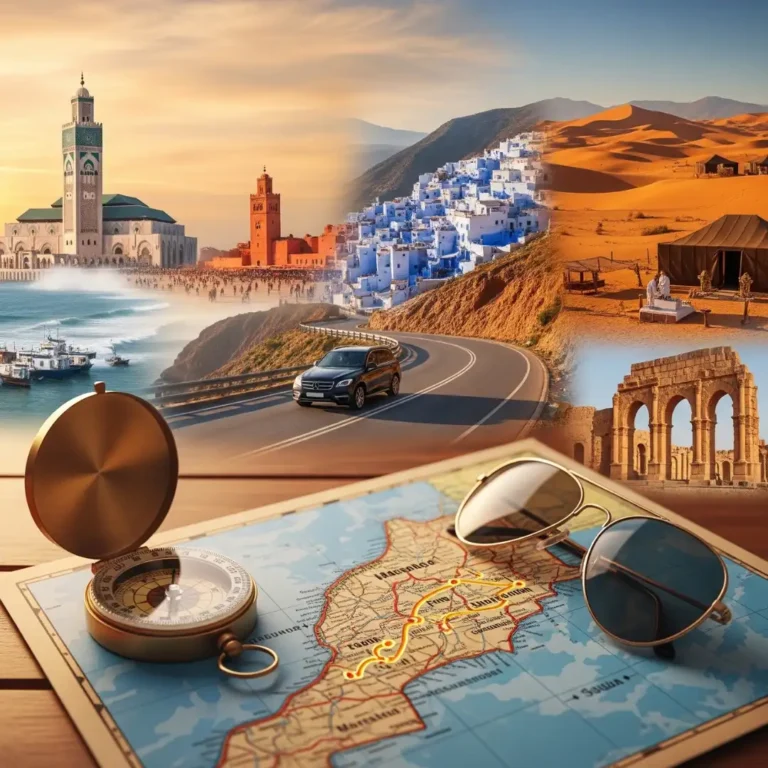Curious? Ask...
Inspire Me...
See Our World
We serve mint tea and hot updates. Subscribe and sip both!
We serve mint tea and hot updates. Subscribe and sip both!
Free things to do in Rabat | Kasbah of the Udayas – Explore a historic fortress with traditional architecture, quiet alleys, and a public Andalusian garden. One of Rabat’s top free cultural attractions.
Free things to do in Rabat | Kasbah of the Udayas is not just a location — it’s an experience tucked behind sandstone walls and painted in shades of soft blue. You don’t need a ticket. You don’t need a plan. Just step in and let the rhythm of old Rabat surround you.
Built in the 12th century by the Almohads, the kasbah served as a military stronghold overlooking the Bou Regreg river. Today, it still pulses with quiet life. You’ll hear footsteps on cobblestones, the rustle of orange trees, and the hum of daily life carried through its narrow alleys. This site is often one of the first answers to travellers asking about free things to do in Rabat | Kasbah of the Udayas — and for good reason.
The scent of citrus from the Andalusian Garden blends with the breeze from the Atlantic. The kasbah isn’t curated. It’s lived in, walked through, and held together by history and habit. You’ll see traditional Moroccan doorways, worn archways, and quiet locals going about their day, not performing for tourists, but simply being.
It’s one of the few sites in the capital where history hasn’t been cleaned up for tourism. That’s why it stands out among free things to do in Rabat | Kasbah of the Udayas — it’s real, accessible, and deeply rooted. If you’d like to explore how the kasbah fits into Rabat’s official heritage status, UNESCO provides detailed documentation in this official report
It’s one of the few sites in the capital where history hasn’t been cleaned up for tourism. That’s why it stands out among free things to do in Rabat | Kasbah of the Udayas — it’s real, accessible, and deeply rooted. You walk through layers of Rabat’s identity without crossing a turnstile.
The site’s ongoing cultural role has also been noted in regional travel analysis. Go Morocco Now describes the Kasbah of the Udayas as “a cultural treasure that blends architectural elegance with a peaceful community atmosphere,” highlighting its significance not only as a preserved monument but also as a functioning part of daily life in Rabat.
Once you pass through the monumental gate, known as Bab Oudaia, look up. The carved arch bears Almohad details that date back 800 years. As you walk forward, you’ll enter streets painted in blue and white — a colour tradition influenced by Andalusian design, meant to reflect light and cool the walkways.
The main gate of the kasbah, Bab Oudaia, is one of its most striking features. Its design reflects Almohad-era architecture, with carved motifs and proportions typical of the 12th century. According to Museum With No Frontiers, this gate stands as a prime example of early Islamic urban fortifications, combining decorative artistry with defensive function.
On your left, you’ll find the Andalusian Garden, a public space with low orange trees, fountains, and shaded paths. It’s not large, but it offers a quiet place to rest. This garden makes the Kasbah especially attractive for travellers researching free things to do in Rabat | Kasbah of the Udayas with families or kids — peaceful, clean, and open year-round.
To make the most of your day, combine your visit to the kasbah with other free Rabat attractions:
o make the most of your visit to the kasbah, you can easily combine it with other nearby sites that offer just as much charm and accessibility. Start with Andalusian Gardens, which are technically part of the kasbah complex but have their own quiet rhythm. The shaded paths, orange trees, and tiled fountains make this space ideal for resting after exploring the inner alleyways.
Just a short walk east leads to Hassan Tower and the Mausoleum of Mohammed V. This wide, open plaza is home to an unfinished 12th-century minaret and a royal tomb complex, both open to the public. Visitors can walk freely among marble columns, observe the ceremonial guards, and step into one of Morocco’s most important national monuments.
From there, continue into Rabat medina and Rue des Consuls, where the contrast between old architecture and artisanal energy is impossible to miss. This area is known for traditional craftwork, including leather goods, brass lanterns, and carpets. Even if you’re not shopping, it’s a fascinating area to wander, observe, and photograph.
If you’re ready for a slower pace after sightseeing, walk ten minutes south toward Nouzhat Hassan Park. This public space is spacious and well-maintained, with flowerbeds, shaded benches, and quiet lanes perfect for a short break or a casual picnic. Locals often stop here for lunch or rest during their daily errands, and the setting is ideal for pausing before continuing your route.
This loop of locations is entirely walkable and works especially well for self-guided visitors who want to explore Rabat without paying for entry or navigating complex transport routes.
This combination works especially well for walking tours or self-guided travellers.
The kasbah gets busier after midday. If you want quiet streets and better photos, arrive before 10:00 AM. Locals often use the kasbah as a shortcut or a morning walking route, especially during weekdays.
There are no entrance fees, but if someone offers to guide you at the gate, remember it’s optional. Everything inside is easy to explore alone, which is why this spot consistently ranks among the top free things to do in Rabat | Kasbah of the Udayas for independent travellers.
Local families use the garden for playtime, and you may even see students sketching the walls for school assignments — it’s a space that still belongs to the city, not just its visitors.
Cost: Entry is completely free. No ticket or guide is required.
Hours: Open daily. The gardens typically close around sunset.
Footwear: Wear flat shoes — uneven stones and steps throughout.
Toilets: There are no public facilities on-site. Use one in the nearby medina.
Shops & Cafés: Very limited inside the kasbah. You’ll find more options just outside.
Behind the garden, follow the path uphill to a quiet lookout where the city walls meet. While this spot doesn’t offer a sea view, it gives a strong sense of the kasbah’s scale and original purpose.
Watch for mosaic door frames, old wooden lintels, and carved house numbers. These tiny details often go unnoticed, but they add to the sense of place — another reason why this kasbah holds its rank among free things to do in Rabat | Kasbah of the Udayas.

Discover the charm of these free spots, then let us take you further, exploring culture, history, and the heart of Morocco.

Visit Morocco Tours
Escape Alchemist
VMT
Tell us your travel drama, we’ve got solutions!